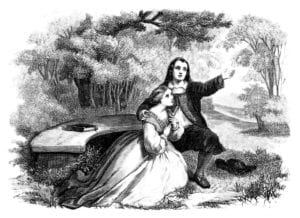We don’t instinctively think of Shakespeare’s plays as having a strong sexual dimension. Perhaps we should. Around half his plays focus on his characters’ sexuality in one way or another. Whether writing about rape (“Titus Andronicus”) or celibacy (“Pericles”), idealistic young love (“Romeo and Juliet”) or cynical sexual exploitation (“Measure for Measure”), the sex-lives of parents (“Hamlet”) or of children (“The Tempest”), sexual infections (“Timon of Athens”) or masturbation (Sonnet 129), Shakespeare returns to the subject of sex with remorseless regularity.
In many cases, his references to sexuality are entirely innocent. When Romeo spends the night with Juliet after he is banished for killing Tybalt, the audience does not enquire too deeply into what happens between them. Similarly, when Iago reveals to Brabantio that his daughter is with Othello, busily “making the beast with two backs”, the audience is more likely to find fault with Iago than with either of the young lovers. But sex in Shakespeare’s plays is rarely this straightforward.
Take rape, for example, a preoccupation in many of Shakespeare’s early plays and a theme throughout his writing. In “The Two Gentlemen of Verona” (c. 1593), Proteus falls in love (or lust) with Silvia, his best friend’s intended, and when she rejects his advances, he threatens to force her to “yield to my desire”. Valentine emerges in the nick of time to prevent this, but it’s striking to modern eyes how Proteus is forgiven not by Silvia but by Valentine. It was rightly said, perhaps, that in this case at least, there are no gentlemen in Verona.
Ugly as this may be, “Titus Andronicus” (c. 1592) offers a still more grotesque case: Lavinia is raped by the brothers Chiron and Demetrius, then mutilated so as to prevent her from reporting what has happened. Later, Titus exacts a chilling revenge, killing the brothers and feeding their remains in a pie to their unwitting mother. It’s worth observing that rape remains a theme throughout Shakespeare’s career: in “The Rape of Lucrece” (1594), for example, the motives of the rapist and the reactions of his victim are exhaustively explored; in “The Tempest”, written nearly two decades later in 1611, Caliban attempts to rape Miranda, and admits he still harbours lustful designs on her.
These various cases represent two extremes on a continuum from “Romeo and Juliet” to “Titus Andronicus”. But there is much in between that is sobering, even at times shocking. For example, sex with an unknown or mistaken partner is a somewhat unlikely theme, but it dominates two of the mid-career Comedies. In “All’s Well That Ends Well” (c. 1604), Helena’s desire to marry Bertram seems likely to be frustrated by his desire for Diana. But Helena secretly takes Diana’s place in Bertram’s bed, leaving him no legal post-coital option but to marry her. In “Measure for Measure” (1604), the corrupt Angelo will only pardon Claudio if his sister Isabella will sleep with him. Isabella enjoins Mariana – once rejected by Angelo – to take her place by stealth, and the unlikely plan succeeds. When Duke Vincentio returns to restore order to the state, he announces plans to marry Isabella himself, while pardoning Claudio – and instructing Angelo to marry Mariana.
Angelo’s corruption is particularly unpleasant because he presents himself as a high-minded puritan, closing Vienna’s brothels while privately nursing exploitative sexual fantasies. Brothels are a familiar feature in Shakespeare’s plays. In the late play “Pericles” (1608), the blameless Marina, apparently orphaned, is abandoned in a brothel – from which her virtues eventually secure her release, followed by reconciliation with long-lost parents. By contrast, in “Henry IV Part Two” (1599), the prostitute Doll Tearsheet is presented as a loose-living, hard-drinking paramour – or “road”, as Prince Hal ungallantly describes her calling – infected according to Falstaff’s testimonial with syphilis.
Elsewhere, infidelity and suspicion of adultery are routinely explored in these plays. In “The Winter’s Tale”, Leontes sacrifices everything to his suspicion that his wife Hermione and his oldest friend Polixenes have had an affair. It isn’t so. In “The Merry Wives of Windsor”, by contrast, Falstaff would welcome some illicit romance were either Mistress Ford or Mistress Page willing to accommodate his desires. They aren’t, and in this they recall the example of the Countess of Salisbury in “Edward III”, who resolutely resists the advances of the King.
The most powerful statement about sexual suspicion in Shakespeare is perhaps “Othello” (1604). This play is laced throughout with a kind of suppressed sexuality, but suspicion of infidelity is its central trigger. From the opening scene, Iago’s project is to underline the Moor’s relationship with his wife Desdemona, and it seems that his motive (in so far as he has one) is partly sexual: jealousy of Othello, a misplaced (and absurd) sense of rivalry with him, lust for Desdemona. It’s telling that the play ends in Desdemona’s bedroom, and her life is eclipsed on her marriage sheets.
It’s a striking fact how often Shakespeare’s villains (his “Vices”, to adopt the term of the Medieval Mystery Plays) appear to harbour sexual motives to drive their campaigns. Edmund in “King Lear” is involved in a “love triangle” while both Goneril and Regan compete to share his bed. Meanwhile Don John in “Much Ado About Nothing” targets Hero’s forthcoming wedding as the moment to fabricate accusations of infidelity. Richard III, sexually insecure and frustrated, believes that because he is “not shaped for sportive tricks”, and therefore “cannot prove a lover”, he is instead “determined to prove a villain”, while (as noted above) Angelo, deputising for Vincentio as governor of Vienna in “Measure for Measure”, will grant Isabella’s request to save her brother from the scaffold if she will sleep with him. Meanwhile, Iago, for whom the word “sleazy” might have been coined, claims that Othello has slept with his wife Emilia, and nurses improbable fantasies about reciprocating with Desdemona.
By contrast, straightforward sexual agency is often placed in female hands in Shakespeare’s writing. The template for this was the early narrative poem “Venus and Adonis” (1593 – 4), in which the unstoppable force of Venus’s sexual desire meets the immovable object of Adonis’s preference to go hunting. Similar frustration arises for Lady Percy in “Henry IV Part One” as she questions why her husband Hotspur has “given my treasures and my rights of thee / To thick-eyed musing”. In “All’s Well That Ends Well” Helena finds her way into Bertram’s bed and secures his hand in marriage thereby, while Cressida in “Troilus and Cressida” is quick to abandon her pledge of fidelity to Troilus once she joins the Greek camp, and Goneril and Regan in “King Lear” compete for Edmund’s sexual favours to their mutual disadvantage. Hamlet, meanwhile, is unambiguous in his revulsion at his mother’s sexuality, accusing her of choosing “the rank sweat of an enseamed bed / Stew’d in corruption, honeying and making love”.
It was mentioned above that references to sexually transmitted diseases are surprisingly common in these plays. Syphilis was new to Europe in the Elizabethan / Jacobean era – imported from the new world, it seems, a consequence of increased global communication – with no effective cure until the mid-twentieth century. But its impact was widely experienced and this features in the plays. “Troilus and Cressida” has so many references to these infections as to be called “the pox play”, and it features a conclusion in which Pandarus, dying of syphilis, is left only to “sweat and seek about for eases”. One such “ease” is referenced in “Henry V”, when Pistol describes his “Dol” as seeking treatment in “the powdering tub of infamy” – a reference to mercury vapour treatment – while Mistress Overdone in “Measure for Measure”, once a “fresh whore”, has now become a “powdered bawd”. Did the author know these diseases from first-hand experience? If so, perhaps he shared the revulsion of Timon, who, disillusioned with human society, enjoins two prostitutes to infect the city with sexual diseases, a declaration of his cynicism and disillusion.
Many of Shakespeare’s references to syphilis are coded in euphemism. Images of “powder” (as mentioned above, a supposed cure for the condition) or “burning” (an apparent consequence of it during urination) often mean more than they seem. Euphemism of all kinds informs numerous sexual refences in the plays in general. Slang words for the vagina include “rose”, “house”, “pie”, “country matters”, “treasure” and “nothing” – which invests new meaning in the title of the romance “Much Ado About Nothing” – while the penis is denoted by “date” (the fruit), “bauble” and “dagger”. In “Venus and Adonis” – a notably erotic poem – the beautiful Venus encourages her reluctant beau to “Graze on my lips, and if those hills be dry / Stray lower, where the pleasant fountains lie”. The publication of this poem in the aftermath of the plague lockdown of 1593 – 4 was met with particular enthusiasm by undergraduates apparently drawn to its erotic sub-text.
And so to love. Romeo and Juliet are drawn to spend the night together by their entirely innocent instincts until they’re divided by their parents’ feuds; similarly, Othello and Desdemona are not to be separated on arrival in Cyprus: “Come, my dear love,” breathes the Moor to his wife, “The purchase made, the fruits are to ensue; / That profit’s yet to come ‘tween me and you”. Not all romance in Shakespeare is so explicitly sexual as this, though even in the depiction of (for example) the romance between Antony and Cleopatra, there is a heady suggestion of eroticism in their embrace.
At the same time, many of the references to sexual activity in Shakespeare’s writing express reservations about it in one form or another. Ferdinand in “The Tempest” may feel intense desire for Miranda, but he is enjoined by Prospero not to “break her virgin-knot before / All sanctimonious ceremonies may / With full and holy rite be minister’d”. In “Hamlet” (1600), similar restraint is urged on Ophelia by Laertes, warning her against leaving “your chaste treasure open / To his [Hamlet’s] unmaster’d importunity”. Unsolicited advice, maybe, but there is the implication here that sexual desire is perilous and should be handled with care.
The Sonnets reach similar conclusions. It’s an axiom that these poems cannot be interpreted as a diary, but the sexuality they disclose (or imply) is rarely far from the surface. Sonnet 20 (“A woman’s face with nature’s own hand painted / Hast thou, the master mistress of my passion”) delivers to the fair youth an arch and unconvincing rejection of sexual relations on the grounds that Nature “pricked thee out for women’s pleasure”. Sonnet 136, by contrast, promises the Dark Lady that “Will will fulfil the treasure of thy love, / Ay, fill it full with wills, and my will one”. These light-hearted puns (“pricked”, “will”) and euphemisms (“treasure”) meet their match in the poet’s savaging of masturbation in Sonnet 129, in which “lust in action” is denounced as an “expense of spirit in a waste of shame”. Happily, much of Shakespeare’s exploration of “lust in action” more generally offers an extraordinarily wide-ranging exploration and portrayal of human sexuality.





One Response
Thorough and enlightening. Further slang words for the sexual organs can be found in ‘The Merry Wives of Windsor’, Act IV Scene i, where Evans is testing young William Page on his Latin declensions. ‘If you forget your quies, your quaes and your quods…’; close puns on the colloquialisms ‘keys’, ‘case’ and ‘cods’ which referred to the penis, vagina and testicles respectively.